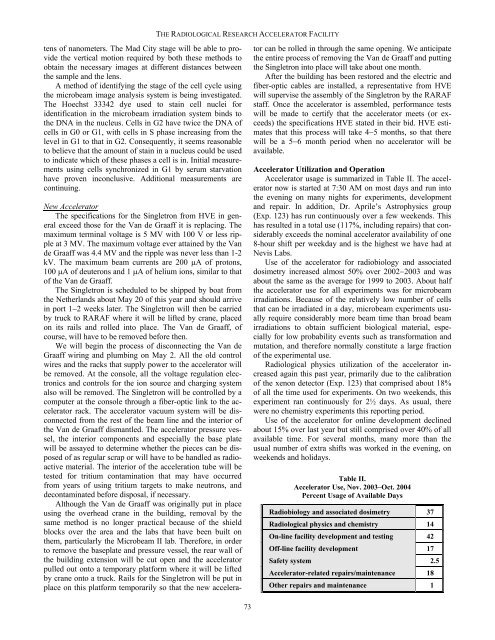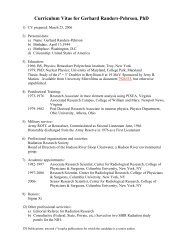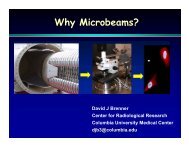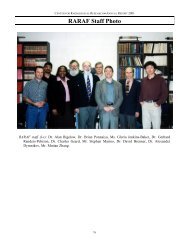LASER ION SOURCE DEVELOPMENT FOR THE - raraf
LASER ION SOURCE DEVELOPMENT FOR THE - raraf
LASER ION SOURCE DEVELOPMENT FOR THE - raraf
Create successful ePaper yourself
Turn your PDF publications into a flip-book with our unique Google optimized e-Paper software.
<strong>THE</strong> RADIOLOGICAL RESEARCH ACCELERATOR FACILITY<br />
tens of nanometers. The Mad City stage will be able to provide<br />
the vertical motion required by both these methods to<br />
obtain the necessary images at different distances between<br />
the sample and the lens.<br />
A method of identifying the stage of the cell cycle using<br />
the microbeam image analysis system is being investigated.<br />
The Hoechst 33342 dye used to stain cell nuclei for<br />
identification in the microbeam irradiation system binds to<br />
the DNA in the nucleus. Cells in G2 have twice the DNA of<br />
cells in G0 or G1, with cells in S phase increasing from the<br />
level in G1 to that in G2. Consequently, it seems reasonable<br />
to believe that the amount of stain in a nucleus could be used<br />
to indicate which of these phases a cell is in. Initial measurements<br />
using cells synchronized in G1 by serum starvation<br />
have proven inconclusive. Additional measurements are<br />
continuing.<br />
New Accelerator<br />
The specifications for the Singletron from HVE in general<br />
exceed those for the Van de Graaff it is replacing. The<br />
maximum terminal voltage is 5 MV with 100 V or less ripple<br />
at 3 MV. The maximum voltage ever attained by the Van<br />
de Graaff was 4.4 MV and the ripple was never less than 1-2<br />
kV. The maximum beam currents are 200 µA of protons,<br />
100 µA of deuterons and 1 µA of helium ions, similar to that<br />
of the Van de Graaff.<br />
The Singletron is scheduled to be shipped by boat from<br />
the Netherlands about May 20 of this year and should arrive<br />
in port 1−2 weeks later. The Singletron will then be carried<br />
by truck to RARAF where it will be lifted by crane, placed<br />
on its rails and rolled into place. The Van de Graaff, of<br />
course, will have to be removed before then.<br />
We will begin the process of disconnecting the Van de<br />
Graaff wiring and plumbing on May 2. All the old control<br />
wires and the racks that supply power to the accelerator will<br />
be removed. At the console, all the voltage regulation electronics<br />
and controls for the ion source and charging system<br />
also will be removed. The Singletron will be controlled by a<br />
computer at the console through a fiber-optic link to the accelerator<br />
rack. The accelerator vacuum system will be disconnected<br />
from the rest of the beam line and the interior of<br />
the Van de Graaff dismantled. The accelerator pressure vessel,<br />
the interior components and especially the base plate<br />
will be assayed to determine whether the pieces can be disposed<br />
of as regular scrap or will have to be handled as radioactive<br />
material. The interior of the acceleration tube will be<br />
tested for tritium contamination that may have occurred<br />
from years of using tritium targets to make neutrons, and<br />
decontaminated before disposal, if necessary.<br />
Although the Van de Graaff was originally put in place<br />
using the overhead crane in the building, removal by the<br />
same method is no longer practical because of the shield<br />
blocks over the area and the labs that have been built on<br />
them, particularly the Microbeam II lab. Therefore, in order<br />
to remove the baseplate and pressure vessel, the rear wall of<br />
the building extension will be cut open and the accelerator<br />
pulled out onto a temporary platform where it will be lifted<br />
by crane onto a truck. Rails for the Singletron will be put in<br />
place on this platform temporarily so that the new accelerator<br />
can be rolled in through the same opening. We anticipate<br />
the entire process of removing the Van de Graaff and putting<br />
the Singletron into place will take about one month.<br />
After the building has been restored and the electric and<br />
fiber-optic cables are installed, a representative from HVE<br />
will supervise the assembly of the Singletron by the RARAF<br />
staff. Once the accelerator is assembled, performance tests<br />
will be made to certify that the accelerator meets (or exceeds)<br />
the specifications HVE stated in their bid. HVE estimates<br />
that this process will take 4−5 months, so that there<br />
will be a 5−6 month period when no accelerator will be<br />
available.<br />
Accelerator Utilization and Operation<br />
Accelerator usage is summarized in Table II. The accelerator<br />
now is started at 7:30 AM on most days and run into<br />
the evening on many nights for experiments, development<br />
and repair. In addition, Dr. Aprile’s Astrophysics group<br />
(Exp. 123) has run continuously over a few weekends. This<br />
has resulted in a total use (117%, including repairs) that considerably<br />
exceeds the nominal accelerator availability of one<br />
8-hour shift per weekday and is the highest we have had at<br />
Nevis Labs.<br />
Use of the accelerator for radiobiology and associated<br />
dosimetry increased almost 50% over 2002−2003 and was<br />
about the same as the average for 1999 to 2003. About half<br />
the accelerator use for all experiments was for microbeam<br />
irradiations. Because of the relatively low number of cells<br />
that can be irradiated in a day, microbeam experiments usually<br />
require considerably more beam time than broad beam<br />
irradiations to obtain sufficient biological material, especially<br />
for low probability events such as transformation and<br />
mutation, and therefore normally constitute a large fraction<br />
of the experimental use.<br />
Radiological physics utilization of the accelerator increased<br />
again this past year, primarily due to the calibration<br />
of the xenon detector (Exp. 123) that comprised about 18%<br />
of all the time used for experiments. On two weekends, this<br />
experiment ran continuously for 2½ days. As usual, there<br />
were no chemistry experiments this reporting period.<br />
Use of the accelerator for online development declined<br />
about 15% over last year but still comprised over 40% of all<br />
available time. For several months, many more than the<br />
usual number of extra shifts was worked in the evening, on<br />
weekends and holidays.<br />
Table II.<br />
Accelerator Use, Nov. 2003–Oct. 2004<br />
Percent Usage of Available Days<br />
Radiobiology and associated dosimetry 37<br />
Radiological physics and chemistry 14<br />
On-line facility development and testing 42<br />
Off-line facility development 17<br />
Safety system 2.5<br />
Accelerator-related repairs/maintenance 18<br />
Other repairs and maintenance 1<br />
73







